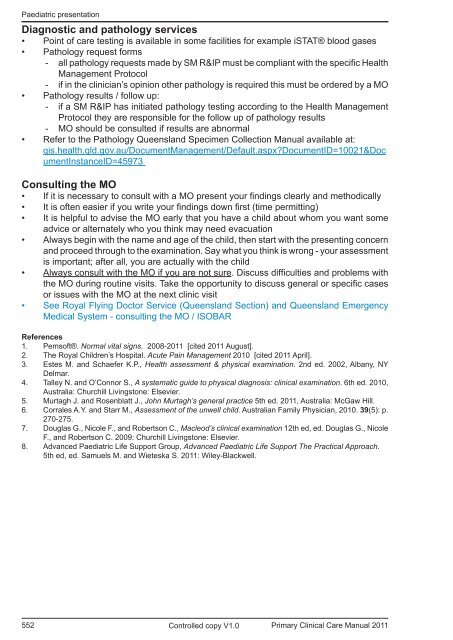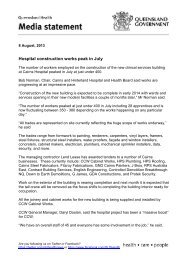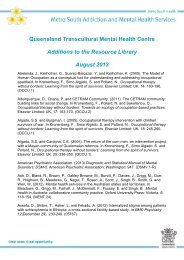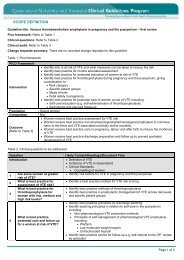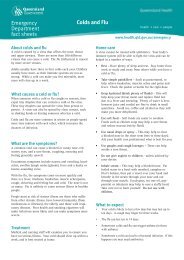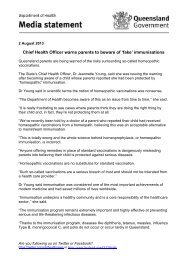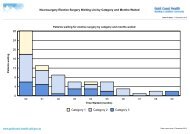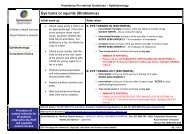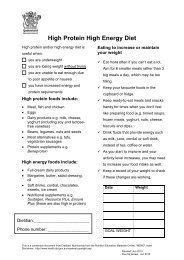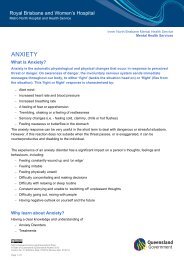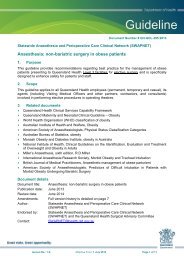Paediatrics - Queensland Health - Queensland Government
Paediatrics - Queensland Health - Queensland Government
Paediatrics - Queensland Health - Queensland Government
You also want an ePaper? Increase the reach of your titles
YUMPU automatically turns print PDFs into web optimized ePapers that Google loves.
Paediatric presentation<br />
Diagnostic and pathology services<br />
• Point of care testing is available in some facilities for example iSTAT® blood gases<br />
• Pathology request forms<br />
-- all pathology requests made by SM R&IP must be compliant with the specific <strong>Health</strong><br />
Management Protocol<br />
-- if in the clinician’s opinion other pathology is required this must be ordered by a MO<br />
• Pathology results / follow up:<br />
-- if a SM R&IP has initiated pathology testing according to the <strong>Health</strong> Management<br />
Protocol they are responsible for the follow up of pathology results<br />
552<br />
-- MO should be consulted if results are abnormal<br />
• Refer to the Pathology <strong>Queensland</strong> Specimen Collection Manual available at:<br />
qis.health.qld.gov.au/DocumentManagement/Default.aspx?DocumentID=10021&Doc<br />
umentInstanceID=45973<br />
Consulting the MO<br />
• If it is necessary to consult with a MO present your findings clearly and methodically<br />
• It is often easier if you write your findings down first (time permitting)<br />
• It is helpful to advise the MO early that you have a child about whom you want some<br />
advice or alternately who you think may need evacuation<br />
• Always begin with the name and age of the child, then start with the presenting concern<br />
and proceed through to the examination. Say what you think is wrong - your assessment<br />
is important; after all, you are actually with the child<br />
• Always consult with the MO if you are not sure. Discuss difficulties and problems with<br />
the MO during routine visits. Take the opportunity to discuss general or specific cases<br />
or issues with the MO at the next clinic visit<br />
• See Royal Flying Doctor Service (<strong>Queensland</strong> Section) and <strong>Queensland</strong> Emergency<br />
Medical System - consulting the MO / ISOBAR<br />
References<br />
1. Pemsoft®. Normal vital signs. 2008-2011 [cited 2011 August].<br />
2. The Royal Children’s Hospital. Acute Pain Management 2010 [cited 2011 April].<br />
3. Estes M. and Schaefer K.P., <strong>Health</strong> assessment & physical examination. 2nd ed. 2002, Albany, NY<br />
Delmar.<br />
4. Talley N. and O’Connor S., A systematic guide to physical diagnosis: clinical examination. 6th ed. 2010,<br />
Australia: Churchill Livingstone: Elsevier.<br />
5. Murtagh J. and Rosenblatt J., John Murtagh’s general practice 5th ed. 2011, Australia: McGaw Hill.<br />
6. Corrales A.Y. and Starr M., Assessment of the unwell child. Australian Family Physician, 2010. 39(5): p.<br />
270-275.<br />
7. Douglas G., Nicole F., and Robertson C., Macleod’s clinical examination 12th ed, ed. Douglas G., Nicole<br />
F., and Robertson C. 2009: Churchill Livingstone: Elsevier.<br />
8. Advanced Paediatric Life Support Group, Advanced Paediatric Life Support The Practical Approach.<br />
5th ed, ed. Samuels M. and Wieteska S. 2011: Wiley-Blackwell.<br />
Controlled copy V1.0<br />
Primary Clinical Care Manual 2011


